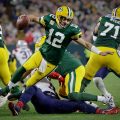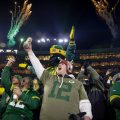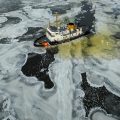Here are some of my favorite photos from a day of drone photography in Door County, Wisconsin. I’d been meaning to get up to Door County to shoot some drone photos since the beginning of the winter, but I never made it happen. Everything lined up last Saturday and I made the one hour trek north of my home in Green Bay. The weather gods blessed me with an amazing day – blue sky, no wind and just warm enough temps to still give me winter shots, but not so cold that I had any cold related drone problems. I’ve flow the drone in temps down to about 10 degrees and at that temp you start having battery issues with not only the drone, but also with the monitor for your controller. I’ve even read about people having problems with icing on the props of their drones when in humid conditions like flying over water in the winter. One of the awesome things about flying over the waters of Lake Michigan in the winter months is that the water is glassy and calm, and on a day like Saturday, you get the extra dimension of terrain below the ice surface.
Door County is the county in the United States with the most lighthouses, so I put three of my favorites on the agenda, starting with sunrise at the Sturgeon Bay Canal Lighthouse, a mid morning stop at the Cana Island Lighthouse and ending with sunset at the Sherwood Point Lighthouse on the west end of the bay of Sturgeon Bay. I also shot a ferry boat headed from the tip of Door County to Washington Island, did a flight over freighters in for winter repairs in Sturgeon Bay, shot a winding road at the top of the peninsula and stumbled across a cool shot of an orchard north of Sister Bay.
I had my regular still cameras with me on Saturday, but I never took them out of the car. The drone gives you perspectives you can’t get without one; you can also quickly move around a scene. I’ve shot sunrise at plenty of lighthouses and usually I’m kind of stuck in one spot in those golden minutes just before and after the sun pops over the horizon. With a drone you can quickly move around the scene giving you so many different looks, not only with how the light is hitting something, but also the height and distance. With a drone you can legally fly up to 400 feet above ground level and this can give you some cool angles, but I find I’m liking my shots from much lower – 50, 100, 200 feet above the ground. I spent years asking pilots on aerial shoots in planes and helicopters if we could get any lower. With a helicopter or plane, the pilot generally doesn’t like to (and legally can’t) get any lower than a 1,000 feet above populated areas and 500 feet in unpopulated areas. They also need to keep their distance from structures. But with a drone your limitations are much less. I flew the drone after sunset and this is only legal within limits: if your drone is equipped with the proper lighting; and only for a half hour after sunset and a half hour before sunrise without a special FAA waiver. Some pilots think the blinking lights on their drones are enough, but the lighting you put on the drone needs to have a range of 3 miles visibility.
I’ve had a number of people ask me how to go about getting a commercial drone license, the FAA Part 107 license. This is the license you need to legally fly a drone for anything business related, from a realtor taking a few photos of a listing to a farmer inspecting crops on his own farm. If you live in northeastern Wisconsin, I highly recommend taking classes from Bill Bongle at Titletown Drones. I took two classes from Bill: the Intro to Drone class; and the Commercial Drone Operator: Part 107 test prep class. These two classes will give you a comprehensive understanding of drones and prepare you to take the test with just a few more hours of indepedent study. You could probably even skip the Intro to Drone class, but it is helpful. Titletown Drones also sells drones and their prices are very competitive with what you can find online. If you’re lucky, Bill will also help you get everything set up properly. Bill has been great resource for me to ask questions of as I’ve ventured deep into the drone photography world.
For those of you curious what kind of drone I used, it was a DJI Mavic 2 Pro with a fixed 24mm lens. I obtained my FAA license last year so I’m able to use the drone as part of my professional photography business. It was well worth the time and investment in studying. The drone has quickly become a favorite tool in giving a different angle on some amazing landscape subjects right in my backyard.
Thanks for looking!
Mike

.jpg)
.jpg)
.jpg)
.jpg)
.jpg)
.jpg)
.jpg)
.jpg)
.jpg)
.jpg)
.jpg)
.jpg)
.jpg)
.jpg)
.jpg)
.jpg)
.jpg)
.jpg)
.jpg)
.jpg)
.jpg)
.jpg)
.jpg)
.jpg)
.jpg)
.jpg)
.jpg)





